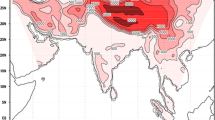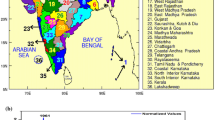Abstract
The heaviest monsoon rainstorm of the period 1951–2007 over India occurred during 23–28 July 2005, mostly the peninsula received rainfall, and each day the rainwater over the country was 40.0 bcm (billion cubic meter) or more, highest 98.4 bcm fell on 25 July 2005. Present premise of monsoon genesis is that it evolves in association with spreading and intensification of equatorial atmospheric condition over Afro-Eurasian landmass and adjoining Indian and Pacific Oceans during boreal summer. Robust natural criteria have been applied to demarcate monsoon and other global weather regimes (GWRs) at standard levels (1000‒100 hPa). Global atmospheric (1000‒100 hPa) thermal condition and monsoon and general circulations during 23–28 July 2005 have been compared with normal features of respective parameters. Over tropics-subtropics (45°S–45°N), troposphere (1000‒250 hPa) was warmer-thicker and pressure lower than normal and mixed conditions of positive/negative departures in temperature, height/thickness and pressure over northern and southern mid-high latitudes. Noticeable changes in 3D monsoon structure were: horizontally spread and eastward-southward shifted over western North Pacific and stretched further southeastward across equatorial Pacific; intense warm-low lower tropospheric confluence-convergence across Asia–Pacific with vertical depth extending beyond 400 hPa; and intense warm-high upper tropospheric anticyclonic circulation zonally stretched and divided into three interconnected cells. Outflows from anticyclonic cells over Tibetan plateau and western North Pacific were mostly directed westward/southwestward/southward. Troposphere was warmer-thicker and pressure higher over eastern part of both subpolars-polars and cooler-thinner and pressure lower over western part. During the period, a deep cyclonic circulation moved from Bay of Bengal through central India while near-stationary atmospheric condition prevailed across the globe.














Similar content being viewed by others
References
Ajayamohan RS, Merryfield WJ, Kharin VV (2010) Increasing trend of synoptic activity and its relationship with extreme rain events over Central India. J Clim 23:1004–1013
Bohra AK et al (2006) Heavy rainfall episode over Mumbai on 26 July 2005. Assessment of NWP guidance. Curr Sci 90(9):1188–1194
De US, Dutta S (2005) West coast rainfall and convective instability. J Ind Geophys Union 9(1):71–82
Durman CF, Gregory JM, Hassell DC, Jones RG, Murphy JM (2001) The comparison of extreme European daily precipitation simulated by a global and a regional climate model for present and future climates. Q J R M S 127:1005–1015
Francis PA, Gadgil S (2006) Intense rainfall events over the west coast of India. Meteorol Atmos Phys 94:27–42
Goswami P, Ramesh KV (2008) Extreme rainfall events: vulnerability analysis for disaster management and observation system design. Curr Sci 94(8):1037–1044
Goswami BN, Venugopal V, Sengupta D, Madhusoodanan MS, Xavier PK (2006) Increasing trend of extreme rain events over India in a warming environment. Science 314:1442–1445
Guhathakurta P, Sreejith OP, Menon PA (2011) Impact of climate change on extreme rainfall events and flood risk in India. J Earth Syst Sci 120(3):359–373
Hunt JCR, Burgers JM (2002) Floods in a changing climate: a review. Phil Trans R Soc Lond A 360:1531–1543
IPCC (2007) Climate change 2007. The physical science basis. The contribution of working group I to the fourth assessment report of the intergovernmental panel on climate change. Cambridge University Press, Cambridge, pp 504–511
Kharin VV, Zwiers FW (2000) Changes in the extreme in an ensemble of transient climate simulations with a coupled atmosphere-ocean GCM. J Climate 13:3760–3788
Klein Tank AMG et al (2006) Changes in daily temperature and precipitation extremes in Central and South Asia. J Geophys Res 111:D16105. https://doi.org/10.1029/2005JD006316
Kumar A, Didhia J, Rotunno Niyogi D, Mohanty UC (2008) Analysis of the 26 July 2005 heavy rain event over Mumbai, India using the weather research and forecasting (WRF) model. Q J R Meteorol Soc 134:1897–1910
Kundzewicz ZW, Rosbjerg D, Simonovic SP, Takeuchi K (eds) (1993) Extreme hydrological events: precipitation, floods, and droughts. IAHS Publication No. 213. IAHS, Wallingford, p 74
NDMG (National Disaster Management Guidelines) (2008) Management of floods. National Disaster Management Authority, New Delhi
Qian W, Lee DK (2000) Seasonal march of Asian summer monsoon. Int J Climatol 20:1371–1386
Rajeevan M, Bhate J (2008) A high resolution daily gridded rainfall Data Set (1971–2005) for Mesoscale Meteorological Studies. National Climate Center, India meteorological Department, research report No.9
Rajeevan M, Bhate Jyoti, Jaswal AK (2008) Analysis of variability and trends of extreme rainfall events over India using 104 years of gridded daily rainfall data. Geophys Res Lett 35:L18707
Rama Rao YV, Hatwar HR, Salah AK, Sudhakar Y (2007) An experiment using the high-resolution Eta and WRF models to forecast heavy precipitation over India. Pure Appl Geophys 164:1593–1615
Ramage CS (1971) Monsoon Meteorology. International geophysics series, 15th edn. Academic Press, New York, p 290
Ranade A (2010) Studies on hydrological wet season and occurrence of dry and wet spells over river basins of India. Ph.D. thesis, Atmospheric and Space Sciences, University of Pune, India, p 372
Ranade A, Singh N (2014) Large-scale and spatio-temporal extreme rain events over India: a hydrometeorological study. Theor Appl Climatol 115:375–390
Ranade A, Singh N, Singh HN (2010) Effect of La Niña-El Niño on climatic fluctuations over major hydro-ecozones across India. J Hydrol Res Devp 25:13–36
Saha S et al (2010) The NCEP climate forecast system reanalysis. Bull Am Meteorol Soc 91(8):1015–1057. https://doi.org/10.1175/2010BAMS3001.1
Saha S et al (2014) The NCEP climate forecast system version 2. J Climate 27:2185–2208. https://doi.org/10.1175/JCLI-D-12-00823.1
Sen Roy S, Balling RC (2004) Trends in extreme daily precipitation indices in India. Int J Climatol 24:457–466
Senior CA, Jones RG, Lowe JA, Durman CF, Hudson D (2002) Predictions of extreme precipitation and sea-level rise under climate change. Phil Trans R Soc Lond A 360:1301–1311
Shyamala B, Bhadram CVV (2006) Impact of mesoscale-synoptic scale interactions on the Mumbai historical rain event during 26–27 July 2005. Curr Sci 91(12):1649–1654
Sikka DR, Rao PS (2008) The use and performance of mesoscale models over the Indian region for two high-impact events. Nat Hazards 44:353–372
Singh N, Ranade A (2010) The wet and dry spells across India during 1951–2007. J Hydrometeorol 11:26–45
Strahler A (2011) Introducing physical geography, 5th edn. Wiley, New Jersey
Vaidya SS, Kulkarni JR (2007) Simulation of heavy precipitation over Santacruz, Mumbai on 26 July 2005, using mesoscale model. Meteorol Atmos Phys 98:55–66
Zwiers FW, Kharin VV (1998) Changes in the extremes of the climate simulated by CCC GCM2 under CO2 doubling. J Climate 11:2200–2222
Acknowledgements
First author is extremely gratefully to Dr. S. K. Jain, Director, National Institute of Hydrology, Roorkee for necessary facilities to pursue the study. This research project is sponsored by Department of Science and Technology (DST), Govt. of India for which she is greatly indebted. We are greatly indebted to Dr. Michael L. Kaplan and one anonymous referee for their comments and consistent support in preparing the final manuscript.
Author information
Authors and Affiliations
Corresponding author
Additional information
Responsible Editor: M. Kaplan.
Rights and permissions
About this article
Cite this article
Ranade, A., Singh, N. Equatorially/globally conditioned meteorological analysis of heaviest monsoon rains over India during 23–28 July 2005. Meteorol Atmos Phys 131, 919–944 (2019). https://doi.org/10.1007/s00703-018-0613-6
Received:
Accepted:
Published:
Issue Date:
DOI: https://doi.org/10.1007/s00703-018-0613-6




